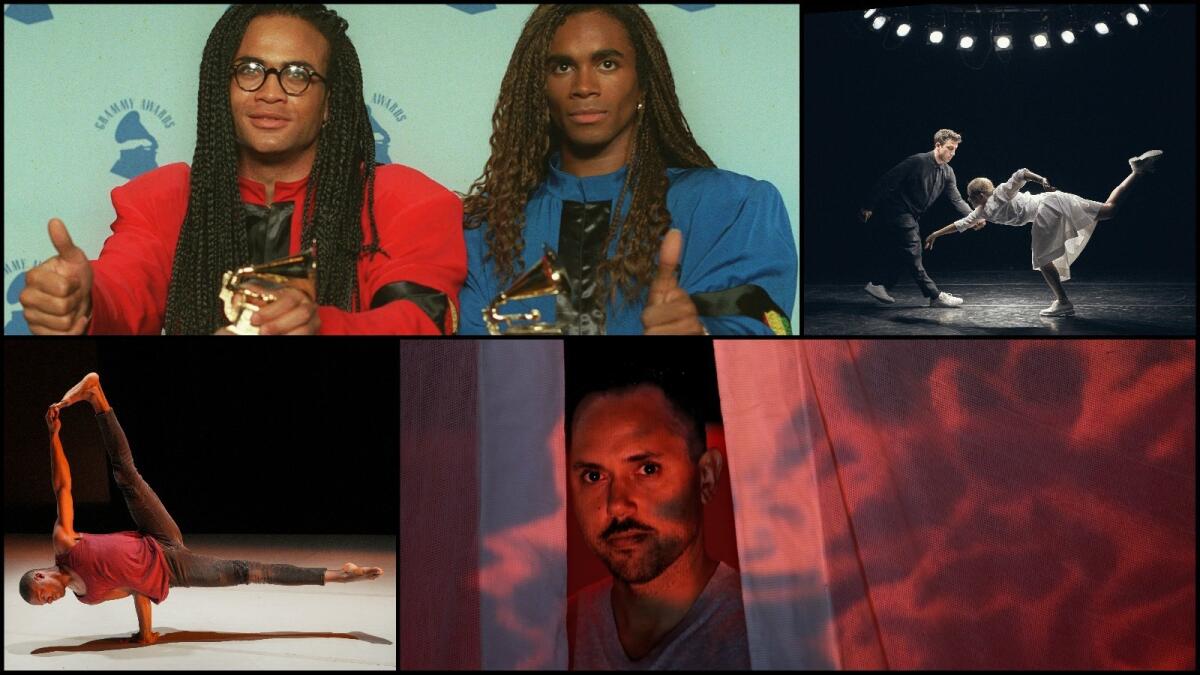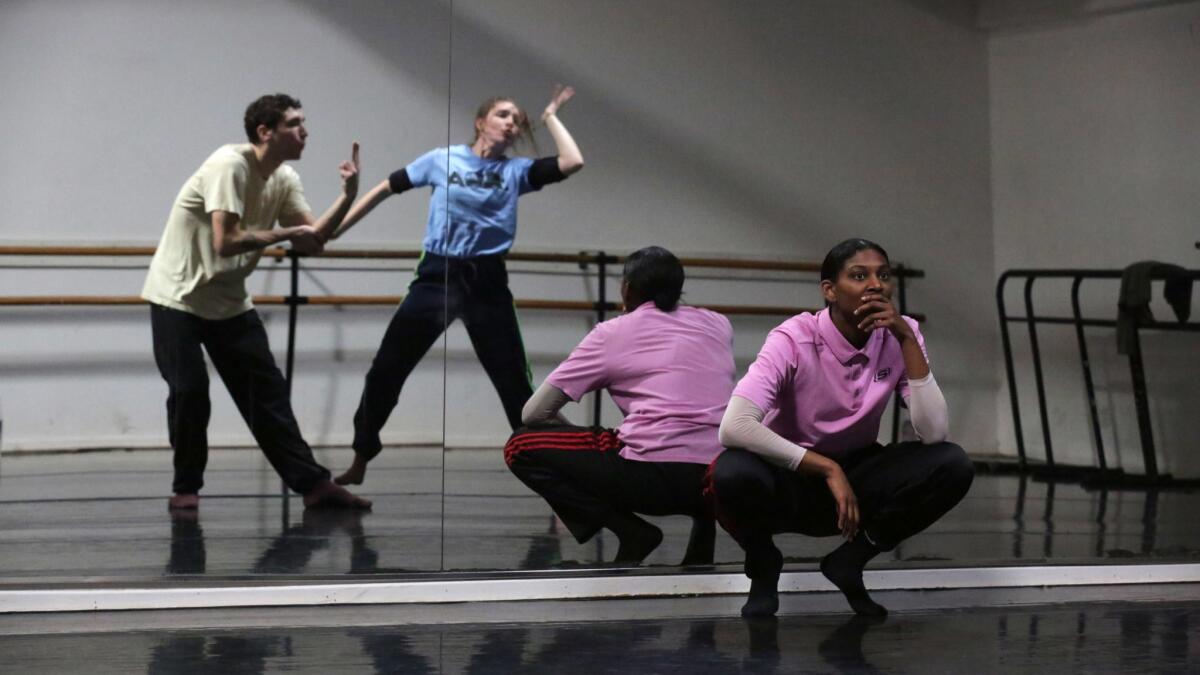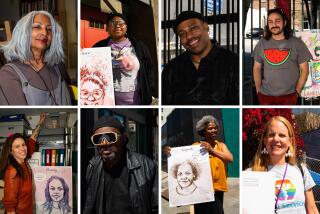‘Artist in residence’: How one phrase is powering L.A.’s cultural explosion

Artist Edgar Arceneaux has been holed up in the community room of the Ford Theatres in Hollywood, finishing his second musical performance piece, “Boney Manilli.” Once again, he’s diving into questions of race and culture, of a white establishment exploiting people of color.
In his 2015 “Until, Until, Until …,” Arceneaux revealed the full story behind Ben Vereen’s misunderstood televised blackface performance for Ronald Reagan’s 1981 inauguration. Now, the artist is turning his sights on Frank Farian, the German record producer behind the Euro-Caribbean pop act Boney M and the infamous lip-syncing duo Milli Vanilli. Farian set up Rob Pilatus and Fabrice “Fab” Morvan as the front men of the latter group, then let them crash and burn after they were unmasked as lip-syncers and stripped of their 1989 Grammy for best new artist.
“We’re looking at the rise and fall of Milli Vanilli as the core story,” Arceneaux said, making an unlikely protagonist out of Pilatus, who died in 1998 at age 32 after being “chucked into the bin of infamy.”
“We’re telling this particular story about how dangerous entertainment can become when people care more about feelings than facts, when they care more about the music than about people,” Arceneaux said.
“Boney Manilli” is a new work reaching the stage thanks to an old idea: the artist residency. Arceneaux has been working off and on for almost 18 months at the Ford, where Executive Director Olga Garay-English has launched an artist residency program. Taking full advantage of its $80-million renovation, the Ford is giving rehearsal space and money to support the creation of new dance and theatrical projects.

The artist residency has been around for more than 100 years. Two of the earliest retreats were Yaddo in Saratoga Springs, N.Y., and MacDowell Colony in Peterborough, N.H. The original concept was fairly simple: Provide a bucolic place for writers, artists, composers and other creative souls to live and work for a fixed period. Sometimes, they received a stipend. The collegiality and camaraderie of other artists served as a wellspring of inspiration. There were no strings attached.
Los Angeles hasn’t been known for its residencies, but that story is changing. As the city has become a nexus for innovation in dance, music and other forms of performance, more local institutions are stepping up to support artistic development and the creation of new work. Besides top-level appointments, such as Yuval Sharon’s three-year residency at the Los Angeles Philharmonic, venues such as the Wallis Annenberg Center for the Performing Arts in Beverly Hills and the Center for the Art of Performance at UCLA have their own residencies. In Santa Monica, the Broad Stage’s newly named artistic and executive director, Rob Bailis, said he wants to expand its program.
The oldest continuously operating residency in the L.A. area is believed to be at Santa Monica’s 18th Street Arts Center, which has live-work studios and programs for as many as 50 artists.
“Sometimes, when you’re in the day-to-day swim of your life and responsibility, it’s hard to carve out that concentrated time to dedicate to a new investigation,” said Jan Williamson, the center’s longtime executive director.
“It’s classic research time, really. Scientists need it and artists need it too. It’s foundational for the work. Nobody needs to leave their home to develop their idea, but it can be really important.”
Arceneaux said he could not have completed “Boney Manilli” without the Ford rehearsal room.
“When we didn’t have the space at the Ford, we were hustling to find spaces that can fit us temporarily,” he said. “The space is actually going to change our story. There are things that have happened that are specific to being in that room. There is a really long ramp that is for handicap accessibility. We’ve turned it into a part of the show itself. We’ve choreographed a dance scene on the ramp.”
For large-scale productions in particular, residency funding is critical. Cast and crew should be paid for rehearsals as well as performances, and yet budgeting for that expense can be difficult in a city with high rents. Arceneaux has a cast and crew of 21, and the $15,000 stipend he received from the Ford helped to underwrite some of those costs.

Choreographer Micaela Taylor, another recipient of a Ford residency, said her $10,000 stipend for the creation of her latest piece, “Drift,” allowed her company, TL Collective, to rehearse five days a week instead of three.
“It’s such a joy and a thrill for us,” Taylor said. “It also helps us as a company feel more valued as artists, and I think it’s taken us, as a company, to another level.”
Garay-English has tapped two other local groups for residencies: Arianne MacBean and the Big Show Co. and Versa-Style Dance Company. The residences vary in length and the amount of financial support, from $5,000 to $15,000, and they conclude with a works-in-progress showing or a full-scale performance at the Ford, which covers the production and marketing costs too. Arceneaux’s “Boney Manilli” will take the stage Aug. 8.
“What many people don’t really think about is, artists have to come up with physical and financial resources to create performative work,” Garay-English said.
“I’ve always been of the mindset that the more institutionalized arts organizations can provide the setting for artists, to take away at least one preoccupation of the mountain of things artists have to work with.”
At the Wallis Annenberg Center for the Performing Arts, Artistic Director Paul Crewes reserves two engagements for its resident company. This season’s residency went to Jacob Jonas the Company, which was also granted an extra week in the Wallis’ Lovelace Studio Theater to prepare a new piece. It will premiere in the Wallis’ larger Bram Goldsmith Theater in May.
“There’s no fixed rules,” said Crewes, adding that the residency program may change. “We’ve only had three, but I would like to think that the company will feel a loyalty [to the Wallis] and feel part of the family and get involved with other things. Jacob Jonas is in conversation with the theater’s education team.”
Crewes said he’s not sure that audiences understand what a residency means or pays attention to the designation. But he believes that the theater community does. That can be important for an artist’s future as residencies confer validation and honor, just as prizes do.
The National Endowment for the Arts awarded money to 293 projects that had a residency component in fiscal year 2018. The Alliance of Artists Communities, an international service organization based in Rhode Island, estimated that at least 500 artist residencies are running nationwide, at least 5,000 worldwide. More residencies are available to visual artists, according to Lisa Hoffman, executive director of the alliance, because visual artists often have fewer technical requirements to produce their work. But Hoffman said the number of residencies for performing artists is growing.
Non-arts groups have begun offering residencies to artists whose work they hope will bolster their social mission. The alliance helped the Little Tokyo Service Center, a community development organization, start a residency program that begins its second year June 1 with six artists working on the theme of displacement.
Directors of presenting theaters, which in previous days could count on audiences buying tickets to a constantly rotating slate of out-of town programming, said their roles have changed. Thor Steingraber, executive director of the Younes and Soraya Nazarian Center for the Performing Arts at Cal State Northridge, said resident artists help theaters to build relationships with audiences, and by commissioning new pieces, the presenters help to keep the art form vital.
“I think this is where the meaningful work is for all of us,” Steingraber said. “Even if we wanted to, I don’t think we can afford to churn out the same kind of touring presentations and expect our audiences to grow with us.”
The Soraya’s resident artist for the last four years has been Aspen Santa Fe Ballet. The Soraya helped to underwrite a new ballet by Los Angeles choreographer Cherice Barton, and it will soon announce that Aspen-Santa Fe Ballet will be bringing its “Nutcracker” production to Northridge this December and will cast as many as 80 local children in it.
Israeli-born choreographer Danielle Agami has participated in multiple residencies, including one at the Center for the Art of Performance at UCLA that assisted her with the creation of “Calling Glenn” for her L.A. contemporary company Ate9. She noted that being an artist in the United States has so much to do with creating “a product.”
“I love that somebody sees it,” she said. “But I also feel like the product could change if you had better terms, if you had more time.” That includes time to refine a piece even after it premieres, she said.
Last year, she got a 4 four-month fellowship at the Center for Ballet and the Arts at New York University, during which she made a solo for herself and devised a new kind of ballet class, inspired by the Gaga movement language. She tied together the formative beginnings and later years of her training as a dancer.
“It was very supportive, very much about giving me everything I need in order to spend meaningful time in the studio, thinking about my work,” Agami said. “They provided privacy and a worry-free zone even in the heart of Manhattan. So residencies come to really comfort you as an artist. They really come to tell you, ‘Here you go. Make something.’ I think that’s really crucial.”
=====
Jacob Jonas the Company
What: Two world premiere dances in the company’s final performance as artist in residence at the Wallis Annenberg Center for the Performing Arts
Where: 9390 N. Santa Monica Blvd., Beverly Hills
When: 7:30 p.m. May 10-11
Tickets: $29-$89 (subject to change)
Info: (310) 746-4000, TheWallis.org
Support our coverage of local artists and the local arts scene by becoming a digital subscriber.
See all of our latest arts news and reviews at latimes.com/arts.
More to Read
The biggest entertainment stories
Get our big stories about Hollywood, film, television, music, arts, culture and more right in your inbox as soon as they publish.
You may occasionally receive promotional content from the Los Angeles Times.










